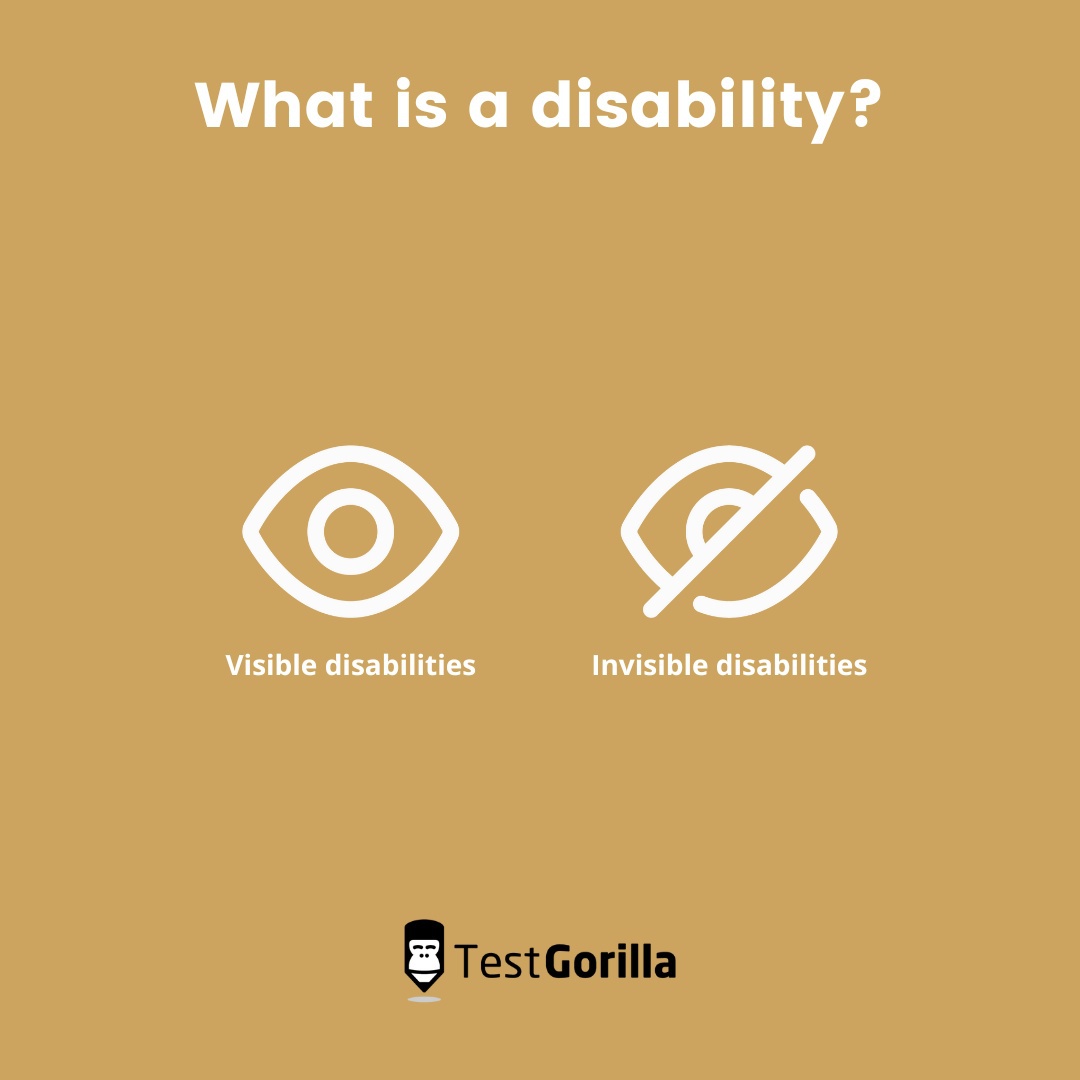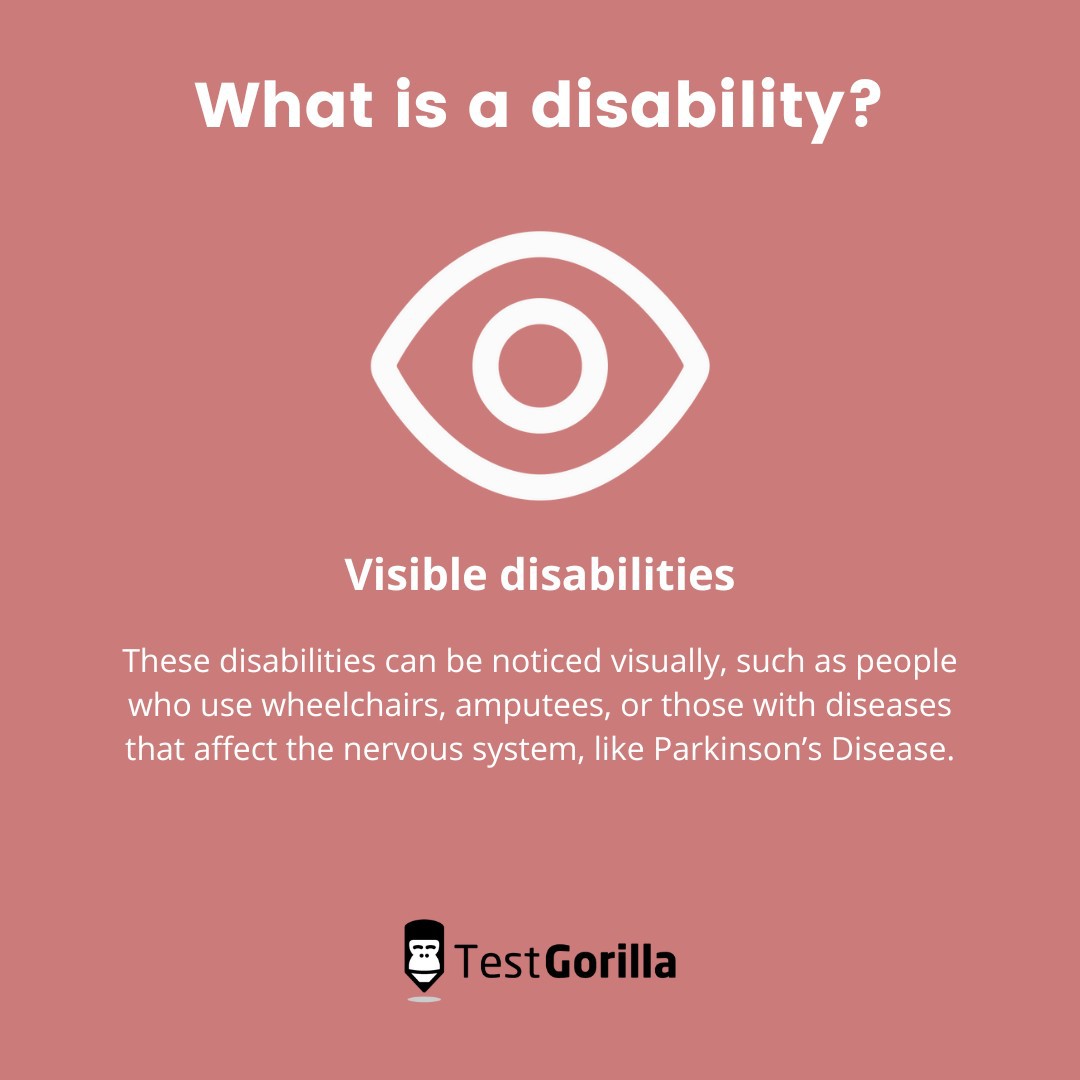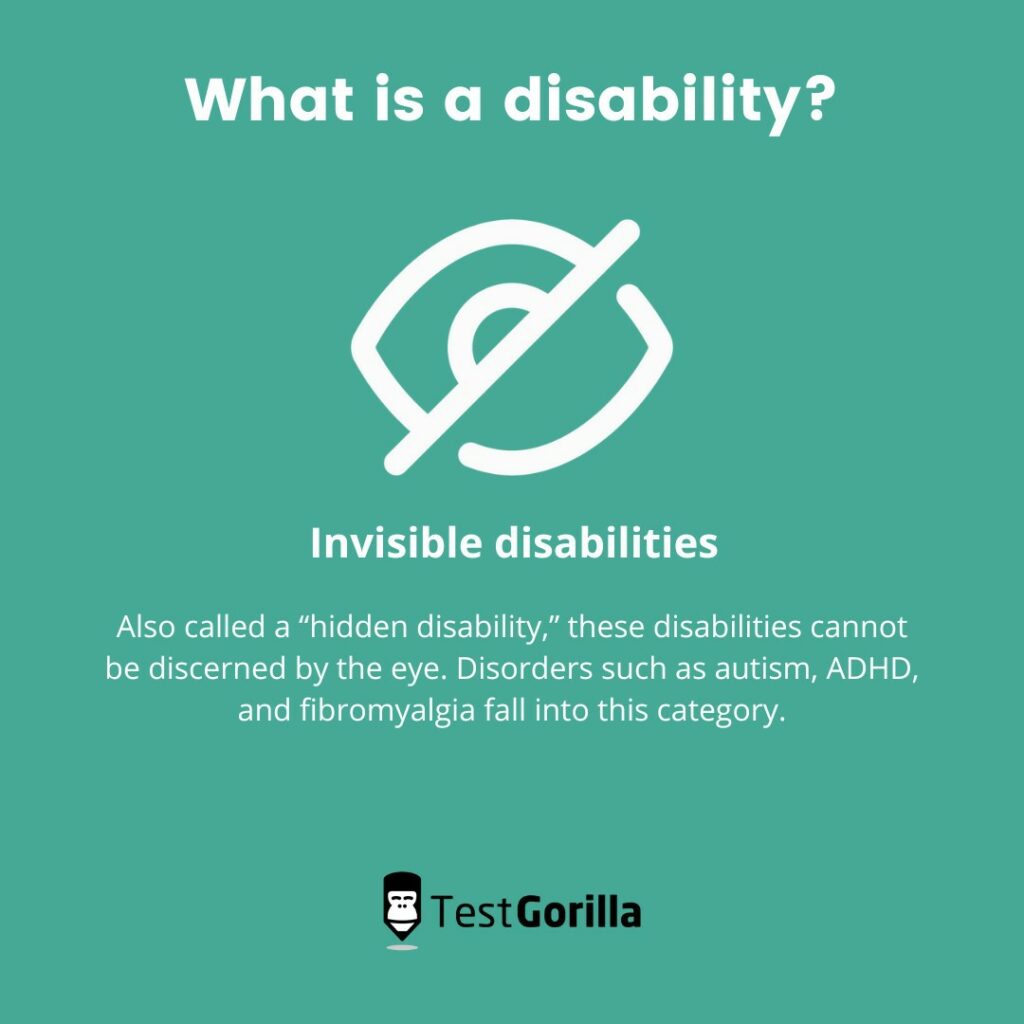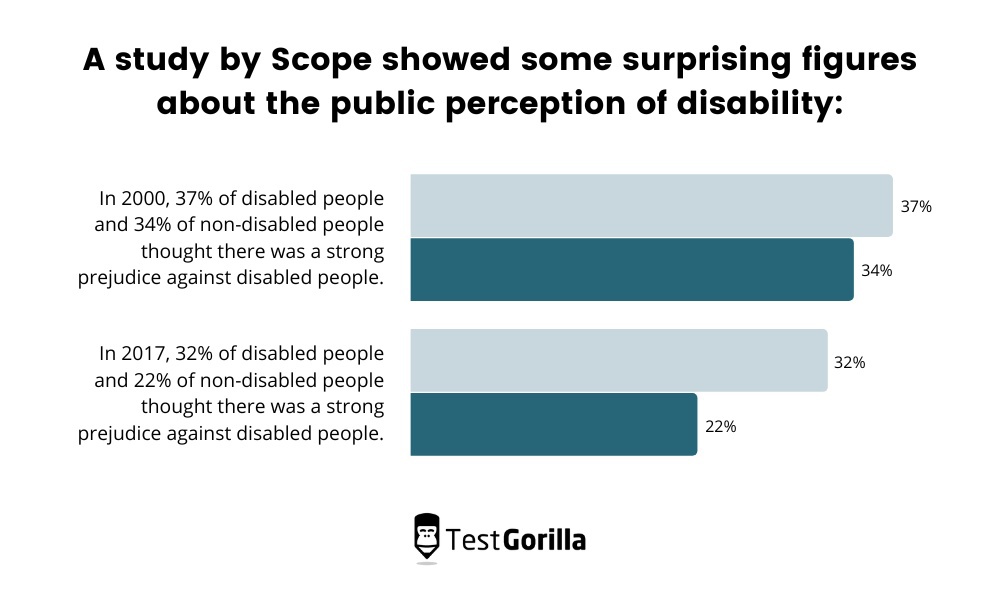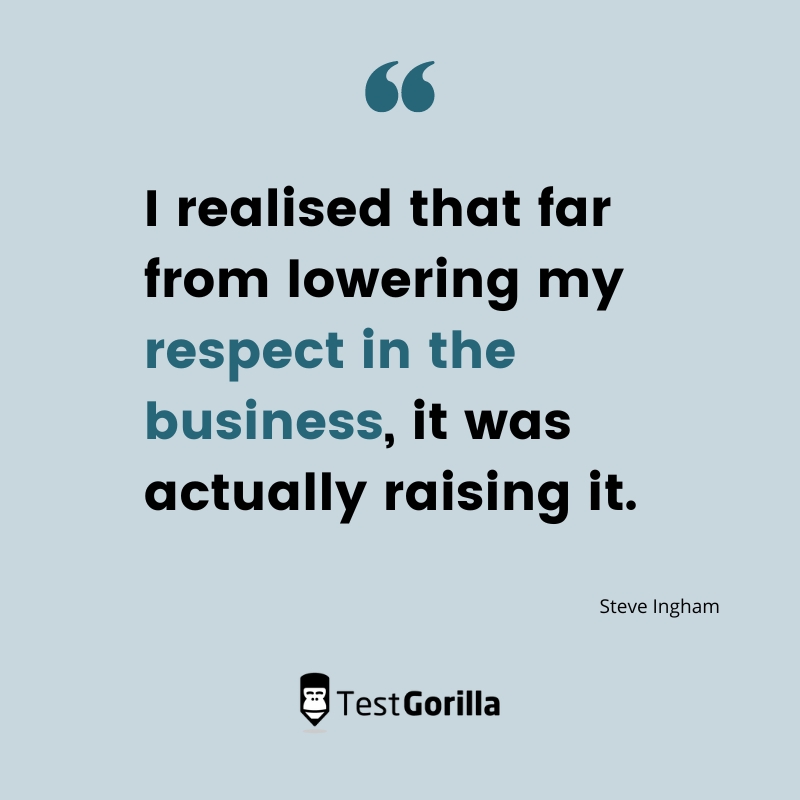Disabled people make up a huge portion of the workforce – one in four adults (26%) in the US have some type of disability.[1]
And yet they face startlingly low employment rates.
Many factors contribute to this, including unconscious bias in the hiring process, lack of necessary accommodations, and low workplace accessibility.
Disability inclusion in the workplace means reducing this bias, improving your work culture, and making your company a safe, positive place for disabled employees to thrive.
Not enough companies are focusing their wider diversity efforts toward this incredibly important demographic, and it’s time to make things better.
In this blog post, we discuss the importance of inclusion, how it benefits your organization, and the top actionable strategies to build better disability inclusion.
Table of contents
What is a disability?
A disability is a condition of the body or mind that limits certain activities and tasks, or makes them more difficult for the person to accomplish.
There are many types of disabilities and they all impact individuals in different ways.
Here are the broad categories of possible disabilities:
Visible disabilities: These disabilities can be noticed visually, such as people who use wheelchairs, amputees, or those with diseases that affect the nervous system, like Parkinson’s Disease.
Invisible disabilities: Also called a “hidden disability,” these disabilities cannot be discerned by the eye. Disorders such as autism, ADHD, and fibromyalgia fall into this category.
Both invisible and visible disabilities impact an employee in cognitive, physical, and emotional ways.
It’s important to note that these aren’t mutually exclusive and many people have overlapping disabilities. One employee could have both invisible and visible disabilities that impact them physically and cognitively.
Disabilities in the workplace can affect an employee in countless ways. One example is a person with dyslexia having trouble reading a work manual that poses no issue to an employee without a disability.
Disabled employees face struggles that many employers don’t realize and don’t understand. These issues can impact their satisfaction, performance, and could even lead to workplace trauma or quiet quitting.
This is why disability inclusion in the workplace is so essential.
What is disability inclusion at work?
Disability inclusion at work is the practice of making an equitable work environment, where disabled employees feel valued and comfortable, and are given equal opportunities as their peers.
There are quite a few ways to approach it, so let’s take a look at some great disability inclusion examples.
Disability inclusion examples
Disability inclusion is a broad topic that includes anything that helps employees with disabilities.
That means reducing unconscious bias towards disabled people, providing necessary accommodations, and a more equitable hiring process are all disability inclusion.
That last point is particularly important. Hiring people with disabilities sometimes isn’t possible without an equitable hiring process.
For example, let’s look at TestGorilla’s special accommodations on pre-employment skills tests.
Depending on the candidate and their disability, there are quite a few ways to make skills tests more accessible:
The option to answer verbally: Facilitates an individual with a motor disability to answer
More time to answer: Assists candidates who have a language processing disorder, who may require extra time
Extra breaks: Helps certain candidates, such as those with ASD, avoid overstimulation
Different formats: Helps those with visual impairments by proving larger print or text that a screen reader can read out
To learn more about implementing special accommodations in your skills-based hiring process, read the full blog on special accommodations skills tests.
The best insights on HR and recruitment, delivered to your inbox.
Biweekly updates. No spam. Unsubscribe any time.
Why is disability inclusion in the workplace important?
Inclusion for disabilities in workplace settings creates a safe, positive space for disabled employees to grow and thrive.
Companies without fair disability inclusion don’t just make things hard for current employees – they also make it hard for new disabled employees to join the organization.
This could be one of the main reasons why the disabled employment gap is so shockingly wide.
Only 53.5% of disabled adults are employed in the UK versus 81.6% of non-disabled adults.
The same study found that only 29% of autistic adults are employed, but a separate study by The National Autistic Society found that 77% of autistic adults want to work.[2]
This is why it’s imperative to give disabled people more opportunities in the workplace. The more we explore accessibility, offer accommodations, and promote inclusivity, the faster we can close this unfortunate employment gap.
For a closer look at the ASD (autism spectrum disorder) employment gap, read our in-depth article.
Disability inclusion is also crucial to improving an organization’s DE&I efforts.
Disability is often overlooked when considering your company’s diversity inclusion initiatives. This means including disability in your diversity hiring metrics and your workplace accessibility efforts.
The more inclusive we are with disability, the more our diversity as a whole increases.
Better inclusion, reasonable accommodations, and accessibility create a safer workplace for disabled people as well as building an overall positive work environment.
The benefits of disability inclusion in the workplace
There are major advantages to becoming an inclusive employer.
From a wider talent pool to increased diversity to boosted innovation, the benefits of disability inclusion in the workplace affect every corner of your organization.
Summary
Benefits | Key takeaways |
A wider talent pool | Better inclusivity broadens your candidate talent pool; Over 25% of people in the US have a disability |
A more diverse workforce | Creating a more fair process increases diversity; Diversity is crucial to employees, candidates, and organizations alike |
A healthier company culture | Better inclusion builds a stronger company culture; A focus on culture add over culture fit creates a healthy environment |
Increased innovation | Inclusivity encourages a wide range of perspectives, increasing innovation |
Increase engagement and retention | Being a fair, equitable employer reduces turnover; Inclusion increases an employee’s loyalty |
Staying on the right side of the law | Many countries have laws surrounding equitable inclusion and following them is imperative; Inclusion for disabled people is simply the right thing to do |
1. A wider talent pool
As we mentioned at the beginning of this blog, over 25% of people in the US have some form of disability.[1]
If your hiring initiatives don’t reach disabled people, you’re missing out on millions of potential candidates.
Hiring people with disabilities requires an inclusive hiring process. By implementing such a process, you exponentially widen your talent pool.
And a fair, inclusive hiring process benefits every candidate – not just the disabled ones.
A study by Qualtrics showed that 54% of workers would be willing to take a pay cut to work at a company with better values. A further 56% wouldn’t even consider a job offer from a company whose values they disagree with.
An accessible and inclusive workplace is key to reaching top talent.
For more strategies and details on the subject, read our blog post on how to expand your talent pool.
2. A more diverse workforce
Facilitating disabled employees to thrive and succeed in your organization encourages a more diverse workforce.
Although disability is often ignored as a diversity metric, it’s an essential part of your company’s DE&I efforts.
The attention to detail an autistic worker brings to your team can be indispensable. The unique perspective of someone suffering from chronic pain and fatigue brings new innovations.
This is exactly the message behind the activist group Disability is Diversity, whose mission is to represent the diversity and innovation in disabled people.[4]
And DE&I efforts are essential to most modern organizations.
Increasingly more organizations are focusing their efforts on boosting diversity. According to TestGorilla’s State of Skills-Based Hiring, 80% of businesses had a goal of increasing diversity in 2022.
Both employees and candidates agree with this drive for better diversity.
Diversity is an element that more and more employees value and look for in an employer. This means higher diversity and inclusion also increase loyalty and morale in current employees.
3. A healthier company culture
When you include people from all walks of life in your company, you encourage the concept of “culture add.”
You may be more familiar with the term “culture fit,” but “culture add” is the idea that you find candidates with similar values to your organization’s own and weave them into your culture. No “perfect fit” is needed.
Culture adds promote diversity, creating a healthier, stronger culture. They also contribute toward a more welcoming, positive workplace for every one of your employees.
Paul Polman, the former chief executive of Unilever, speaks about this in an interview with The Valuable 500, a global disability inclusion company.
Paul talks about disability inclusion and how it impacts your culture and non-disabled employees. He says it creates enormous loyalty among staff, decreases turnover, and increases productivity.
To read more about creating a strong corporate culture, read our blog post on culture add vs culture fit.
4. Increased innovation
An organizational culture filled with diverse backgrounds has increased creativity because you get access to different approaches to problem-solving and new ways of thinking.
When you have employees with different lifestyles, day-to-day activities, and interactions, there’s a whole new range of perspectives open to your company.
Google recognizes this, and that’s why they started Experiments with Google.
This program is all about using the innovation from disability and diversity to create beautiful things and improve businesses and communities alike.
One example is Sarah Ezekiel, an artist diagnosed with motor neurone disease, who worked with her speech and language therapist to develop Look to Speak. This technology enables people to use their eyes to select phrases and have them spoken aloud.
New ideas and creativity are only a sampling of the many advantages inclusivity brings your organization. For more on the topic, read our blog post on the benefits of diversity in the workplace.
5. Increase engagement and retention
Disability inclusion in the workplace increases engagement, retention, and loyalty in employees.
When your workers realize that you see them as complex humans with difficulties and limitations, it makes them more loyal and more likely to stick around.
A study by Limeade supports this claim:
One in three employees left a job because they felt their employer didn’t care about them as a person
One in four employees left a job because they felt they weren’t treated with dignity by company leaders
One in five employees left a job because they felt their employer didn’t support their well-being
Disability inclusion is unfortunately rare and the more you support your disabled employees, the more unique and desirable your organization becomes.
6. Staying on the right side of the law
Disability inclusion carries many benefits, but it’s always important to remember that equality and accessibility for disabled employees can be a legal necessity.
The US Department of Labor prohibits employers from discriminating against qualified workers with disabilities and requires them to take action to employ and advance the disabled workforce.
And the more you stay on the right side of the law, the more your company stays on the up-and-up, which improves your brand image and attracts more candidates to your door.
But it isn’t just the law – it’s also the right thing to do.
Disability inclusion is the best course of action for everyone involved. Disabled candidates get a fair chance, disabled employees have a safe workspace, and companies get amazing talent.
How to build disability inclusion in the workplace
Disability inclusion in the workplace can help millions of people lead better, happier work lives, and it benefits your company, too.
So let’s work to build better disability inclusion practices in your organization using these seven strategies.
Summary
Strategy | Description |
1. Opt for skills-based hiring practices | Focus on skills over degrees and work history to make a more equal playing field |
2. Optimize your hiring initiatives for disabled people | Review your hiring material to ensure inclusive language; Extend your job offers to communities that support disabled workers |
3. Identify and avoid unconscious bias at work | Work to examine unconscious bias and make efforts to reduce it; Understand that unconscious bias happens where you don’t realize |
4. Help managers with disability awareness training | Train your managers on inclusivity, accommodations, and positive language |
5. Ask candidates and employees about necessary accommodations | Reach out to your employees and learn what they need to get their work done |
6. Promote transparency around disabilities | Encourage leaders to open up about struggles; Create a safe space to disclose disabilities |
7. Offer flexible working arrangements | Give disabled employees the option for flexible hours or remote work |
1. Opt for skills-based hiring practices
Skills-based hiring removes unnecessary job requirements and restrictions, instead focusing on skills and capability.
Skills-based hiring practices ensure you hire for skill and that you don’t rely on resumes, which can put disabled people at a disadvantage.
Disabled people are three times more likely to have no educational qualifications than non-disabled people.[3] That means when you launch a job ad with educational requirements, you’re excluding thousands of talented disabled workers.
Skills-based hiring has little to no reliance on requirements like this. Instead, you assess a candidate’s capability through skills tests.
For example, rather than evaluating a potential salesperson through work history and certifications, you can evaluate them with tests such as an Outside Sales test and a Lead Generation test.
Adopting skills-based hiring practices also drastically reduces hiring bias. Disabled candidates face both unconscious and conscious bias, which affects how people rank their applications, resumes, and interview results.
Skills-based hiring practices also enable employers to offer accommodations during skills tests (as we mentioned above), such as providing extra time during tests or allowing extra breaks.
So not only does skills-based hiring remove obstacles for disabled people, it also accommodates disability. This is a crucial factor in leveling the playing field for every candidate.
2. Optimize your hiring initiatives for disabled people
Employing people with disabilities is easier and more inclusive when you update and refine your hiring initiatives.
There are quite a few ways to optimize your hiring efforts for disabled employees. One of your first steps should be checking for non-inclusive language and unconscious biases in the following:
Job descriptions
Marketing material
Hiring material
Your company website
There can be quite a few unconscious biases that slip through in a job description. For example, requiring minimum or maximum years of work experience excludes disabled people who are older or those who have career gaps due to disability.
It’s also important to check your materials for controversial and demeaning terms, such as:
“Differently abled”
“Special needs”
“Physically challenged”
A huge part of disability inclusion is destigmatizing disability, and that includes destigmatizing the use of the word “disabled.”
It shouldn’t be an uncomfortable or taboo word, it’s simply the way some people are.
One other step that leads toward a more inclusive hiring process is taking a proactive approach to recruitment. Reach out to communities, college career centers, and job boards that support disabled people.
This act doesn’t just passively support disabled candidates, it actively shows that you’re targeting their diverse skills and background.
3. Identify and avoid unconscious bias at work
Identifying bias in your organization is one of the most important elements in boosting disability inclusion.
Bias against disabled people is unfortunately common at work. It discourages disabled candidates, makes an uncomfortable workplace for disabled employees, and decreases disability inclusion as a whole.
And unconscious bias can slip right by you.
A study by Scope showed some surprising figures about the public perception of disability:
In 2000, 37% of disabled people and 34% of non-disabled people thought there was a strong prejudice against disabled people
In 2017, 32% of disabled people and 22% of non-disabled people thought there was a strong prejudice against disabled people[5]
There’s been a large gap created since the turn of the millennium. Disabled people still largely feel a bias against them, but the amount of non-disabled people who believe the same has dropped.
This means that non-disabled people may not see the bias around them.
Here are a few steps for identifying unconscious bias in your workplace:
Take complaints about the workplace environment seriously (e.g., text that’s too small or lights that are too bright)
Listen to employees who have trouble walking or standing for prolonged periods
Avoid phrases implying ability, like “you shouldn’t have an issue with that” or “that’s easy”
A lot of unconscious bias comes from the small, seemingly meaningless comments we make to colleagues. Simply taking the time to consider what we say and take concerns seriously is a big step to creating a more fair workplace.
4. Help managers with disability awareness training
A manager is an important part of any employee’s job satisfaction. They should be encouraging and positive with their people.
Educated, empowered, and supportive managers are the key to success, and that includes knowledge and understanding of disability.
As HR, you can help both hiring managers and line managers with specific disability awareness training.
This might involve arranging classes, setting up seminars, or discussing disability awareness during regular 1:1 meetings.
Try talking to your managers about:
Etiquette
Language
Accommodations
Holding accessible meetings and events
A manager is supposed to be a pillar for their people, but it won’t work if they aren’t there for everyone.
Inclusivity and equal treatment are essential factors for superb management. If you’re looking for more on this topic, read our guide on how to be a good manager (and how to hire one).
5. Ask candidates and employees about necessary accommodations
Accommodations aren’t just “nice-to-have,” and they certainly aren’t “perks.” Many disabled employees need accommodations to complete their work at the same level as their non-disabled peers.
Disabilities may need accommodations both during the hiring process and in the workplace itself. When considering accommodations, it’s essential to ask both candidates and employees about the accommodations they personally need to do their best work.
Never assume which accommodations an employee needs. Assumptions can lead you to do something unnecessary, and while your intentions are pure, it isn’t helping them and it’s a waste of your time.
Be open with your employees. To get a better idea about whether you need to implement more accommodations, try asking::
Where support is lacking
What the company can do to make their work easier
Transparency with your employees is a crucial factor and they’ll thank you for it. It’s important for an employer to openly discuss accommodations with their workforce – and it’s also incredibly appreciated.
Let’s talk more about transparency.
6. Promote transparency around disabilities
It’s incredibly powerful to be transparent about disabilities and their difficulties. If employees see leaders genuinely discussing disabilities and their own struggles, they’ll feel safer about discussing their own.
Steve Ingham, the chief executive of PageGroup, lives with a disability himself and believes being transparent about his difficulties makes him and his company stronger.
Steve is open about his challenges, champions for others in the workplace with disabilities, has employee resource groups for underrepresented groups, and puts all his managers through DE&I training.
He says that this vulnerability has made him stronger rather than weaker.
“I realised that far from lowering my respect in the business, it was actually raising it.”
Commitment from leadership tells your employees that your entire organization believes in equity for the disabled, and this type of work environment is essential for true disability inclusion in the workplace.
Creating a workplace culture where it’s safe to disclose a disability and discuss it is imperative. Many disabled people never tell an employer about their challenges out of fear of discrimination, infantilization, and harassment.
And if an employee can’t disclose their issues, it could lead to burnout, quiet quitting, and a loss in performance.
7. Offer flexible working arrangements
Adopting a flexible working policy means that your staff have options for “when and where” they get their work done. This includes remote work and hybrid offices.
Flexible working arrangements are a relief to some disabled people, but are non-negotiable to many.
These help many different types of people, including those with different schedules, physical disabilities, driving disabilities, or severe public anxiety.
Employees with disabilities in the workplace benefit greatly from flexible work – the ability to work where and when they need lets them get their tasks done when they’re most energetic and productive.
That means that some employees get a performance boost from flexible work, and others get the accommodations they need and won’t have to search for another role.
Disability inclusion in the workplace creates a better environment for everyone
Embracing disability inclusion is essential and benefits everyone involved – the individual, the company, and society as a whole.
Inclusivity comes in many varieties, from encouraging transparency to employing people with disabilities through skills-based hiring.
The more we combat unconscious bias and encourage inclusivity, the faster we can close this employment gap and create a safer place for disabled employees.
For more on this inclusivity and its importance, read our blog post on how and why you should prioritize inclusiveness.
To hire more like-minded people who are ready to promote an equitable workplace, use our Business Ethics & Compliance test.
Disclaimer: The information contained in this site is provided for informational purposes only and should not be construed as legal advice on any subject matter. If you have any questions on disability inclusion in your area, please consult with a lawyer.
Sources
“Disability Impacts All of Us”. (May, 2022). Centers for Disease Control and Prevention. Retrieved February 13, 2023. https://www.cdc.gov/ncbddd/disabilityandhealth/infographic-disability-impacts-all.html#:~:text=61%20million%20adults%20in%20the,is%20highest%20in%20the%20South
“The autism employment gap”. (August 31, 2016). The National Autistic Society. Retrieved February 13, 2023. https://www.basw.co.uk/system/files/resources/basw\_53224-4\_0.pdf
“There’s No Diversity, Equity & Inclusion Without Disability”. (n.d.). Disability is Diversity. Retrieved February 22, 2023. https://disabilityisdiversity.com/
“Outcomes for disabled people in the UK: 2021”. (February 10, 2022). Office For National Statistics. Retrieved February 23, 2023. https://www.ons.gov.uk/peoplepopulationandcommunity/healthandsocialcare/disability/articles/outcomesfordisabledpeopleintheuk/2021
“The Disability Perception Gap”. (May, 2018). Scope. Retrieved February 22, 2023. https://www.scope.org.uk/campaigns/disability-perception-gap/
You've scrolled this far
Why not try TestGorilla for free, and see what happens when you put skills first.


